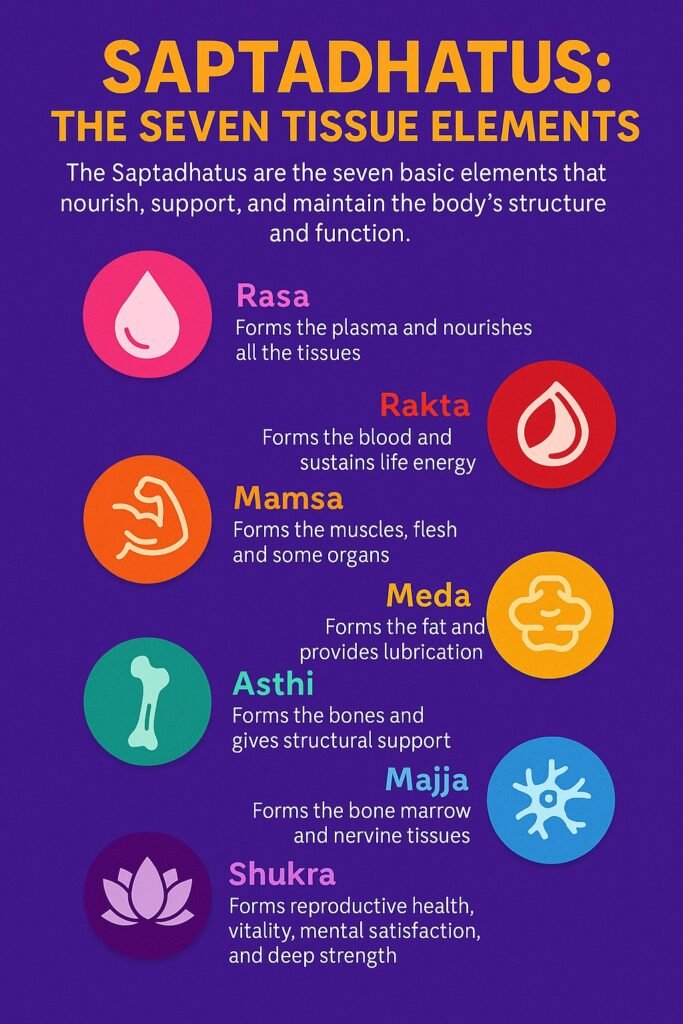
When we think about our health today, we often focus on calories, vitamins, protein shakes, and hitting the gym. But centuries ago, our ancestors in India looked at the body very differently — and remarkably, their approach still makes sense even in this age of modern science. Ayurveda, the ancient science of life, describes the human body as being built and sustained by seven fundamental tissues called the Saptadhatus.
In this detailed, friendly guide, we’ll explore what these seven dhatus are, how they work together, and how we can keep them balanced for vibrant health and inner harmony
.
What Does ‘Saptadhatus’ Mean?
Let’s decode this first:
- ‘Sapta’ means seven
- ‘Dhatu’ means that which sustains or nourishes
In essence, the Saptadhatus are the seven fundamental elements that nourish, sustain, and uphold the body’s structure and vital functions. According to Ayurveda, when these dhatus are healthy and balanced, a person enjoys good immunity, strength, mental clarity, and longevity. If they are disturbed, disease finds a way in.
The Seven Dhatus: A Simple Overview
Ayurveda’s genius lies in its simplicity and depth. The Saptadhatus are arranged in a sequence, each forming and nourishing the next. Let’s meet them one by one in plain language:
- Rasa Dhatu (Plasma / Body Fluids)
- Rakta Dhatu (Blood)
- Mamsa Dhatu (Muscle Tissue)
- Meda Dhatu (Fat Tissue)
- Asthi Dhatu (Bone Tissue)
- Majja Dhatu (Bone Marrow and Nerve Tissue)
- Shukra Dhatu (Reproductive Tissue)
1. Rasa Dhatu — The River of Nourishment
Rasa is the very first dhatu formed after digestion. It is often compared to plasma, lymph, and other body fluids that circulate nutrients to all cells.
👉 Role: It nourishes all tissues, keeps skin glowing, supports immunity, and maintains moisture balance in the body.
👉 Signs It’s Healthy: Clear complexion, good hydration, no dryness, vibrant energy.
👉 Imbalance Shows Up As: Dehydration, dry skin, fatigue, low immunity, emotional sensitivity.
👉 How To Care: Eat freshly cooked, easy-to-digest meals. Drink enough water and herbal teas. Avoid excessive fasting or crash diets.
2. Rakta Dhatu — The Vital Red Juice
Rakta is more than just red blood cells. It represents the vital force that carries oxygen and life throughout the body. Rakta supports vitality, skin colour, and warmth.
👉 Role: Circulates oxygen, detoxifies, boosts energy, and keeps skin bright.
👉 Signs It’s Healthy: Pinkish complexion, good stamina, sharp mind.
👉 Imbalance Shows Up As: Anaemia, skin rashes, inflammation, excess anger.
👉 How To Care: Eat iron-rich foods like leafy greens, beetroot, dates, and pomegranates. Avoid processed foods and overexertion.
3. Mamsa Dhatu — The Muscle Power
Mamsa is the dhatu that forms our muscles, flesh, and some parts of our organs. It gives us strength, form, and courage.
👉 Role: Provides structural support, movement, protection for internal organs.
👉 Signs It’s Healthy: Strong, well-toned muscles, physical endurance, good posture.
👉 Imbalance Shows Up As: Weak muscles, fatigue, joint pain, feeling physically weak.
👉 How To Care: Engage in regular exercise, eat balanced protein (plant or lean animal-based), practice good posture.
4. Meda Dhatu — The Gentle Cushion
Ayurveda views Meda as a protective, lubricating, and energy-reserving tissue that keeps us warm and supports joint flexibility.
👉 Role: Lubricates joints, cushions organs, stores energy.
👉 Signs It’s Healthy: Supple skin, balanced body weight, good flexibility.
👉 Imbalance Shows Up As: Obesity, cholesterol issues, diabetes, or extreme leanness if Meda is deficient.
👉 How To Care: Eat healthy fats like ghee, nuts, seeds in moderation. Avoid excessive fried or processed fats. Stay active to maintain a healthy fat balance.
5. Asthi Dhatu — The Solid Framework
Asthi means bones — the body’s structural framework. It includes bones, cartilage, nails, teeth, and hair roots.
👉 Role: Provides support and protection, stores minerals, houses bone marrow.
👉 Signs It’s Healthy: Strong bones and joints, healthy teeth and nails, good posture.
👉 Imbalance Shows Up As: Weak bones, osteoporosis, brittle nails, hair fall, joint pain.
👉 How To Care: Get adequate calcium and minerals from sesame seeds, dairy, leafy greens. Get sunlight for vitamin D. Practice weight-bearing exercises like walking or yoga.
6. Majja Dhatu — The Vital Essence Inside Bones
Majja refers to bone marrow and also nervous tissue — the deep nourishing juice within our bones and the nerve system that controls our body and mind.
👉 Role: Produces blood cells, nourishes nerves and brain, supports immunity and intelligence.
👉 Signs It’s Healthy: Good memory, sharp intellect, healthy nerve response, robust immunity.
👉 Imbalance Shows Up As: Weak immunity, poor memory, nerve weakness, confusion.
👉 How To Care: Eat nutrient-dense foods like nuts, seeds, healthy fats, milk (if suitable), and rejuvenating herbs like Ashwagandha or Shatavari (consult an Ayurvedic practitioner).
7. Shukra Dhatu — The Seed of Life
Shukra is the final and most refined dhatu, representing the reproductive fluid in men and the ovum in women. It’s the essence of vitality, creativity, and regeneration.
👉 Role: Fertility, life force, mental well-being, and steadfast strength.
👉 Signs It’s Healthy: Healthy reproductive system, good fertility, glow on the face, balanced hormones.
👉 Imbalance Shows Up As: Low libido, infertility, lack of vitality, excessive stress.
👉 How To Care: Eat wholesome food, manage stress, practice moderation in sexual activity, follow a sattvic (pure and balanced) lifestyle.
How Are The Dhatus Formed? The Chain Reaction
Ayurveda beautifully explains that each dhatu nourishes and transforms into the next in sequence. Imagine a farmer planting a seed:
- First comes the sprout (Rasa),
- Then the healthy sap (Rakta),
- Then the trunk and branches (Mamsa),
- The bark and covering (Meda),
- The wood inside (Asthi),
- The pith (Majja),
- And finally, the fruits (Shukra).
This sequential nourishment means if your digestion (Agni) is weak, the chain is broken. That’s why Ayurvedic wellness starts with digestion!
Why Should We Care About Saptadhatus Today?
Modern lifestyle is all about rush — late nights, fast food, stress, screens. This often disrupts our digestion and nutrition, eventually harming the dhatus. By understanding Saptadhatus, we can reconnect with our body’s real needs.
Balanced dhatus mean:
✅ Strong immunity
✅ Healthy weight
✅ Glowing skin and hair
✅ Good energy and mental clarity
✅ Better reproductive health
✅ Long-lasting youthfulness
Practical Tips To Keep Your Dhatus Healthy
Here’s how to start nurturing your Saptadhatus in everyday life:
🌱 Eat According to Season: Prefer fresh, local, and seasonal produce.
🔥 Keep Your Digestion Strong: Eat on time, chew well, don’t overeat.
💧 Stay Hydrated: Warm water and herbal teas help Rasa flow freely.
🧘 Move Your Body: Yoga, walking, or any enjoyable exercise keeps Mamsa and Meda balanced.
🧠 Calm the Mind: Meditation and enough sleep nourish Majja and Shukra.
🫶 Practice Moderation: Avoid overindulgence in food, work, or sexual activity.
🌿 Try Rejuvenating Herbs: Herbs like Ashwagandha, Shatavari, or Triphala can help (consult an Ayurvedic doctor).
A Little Ayurveda Goes a Long Way
Small daily steps add up. Notice what your body tells you — dry skin, fatigue, poor digestion — these are signals that your dhatus need care.
Think of your body not just as muscles and bones but as a dynamic flow of nourishing tissues, each supporting the next. This ancient wisdom invites us to respect our body’s layers, eat mindfully, live in tune with nature, and enjoy a balanced life.
Wrapping Up: The Takeaway
Saptadhatus are not just an old concept locked in textbooks. They are alive in us, sustaining our health day and night. When they’re in harmony, we feel light, happy, energetic, and resilient. When they are not in balance, diseases will slowly start to grow in your body.
By paying attention to what we eat, how we live, and how we manage stress, we can keep these seven pillars strong and steady — building a life full of health and happiness.
So, the next time you sip warm herbal tea, enjoy a mindful meal, or take a deep breath after yoga, remember — you’re feeding your dhatus and celebrating the timeless wisdom of Ayurveda.
I hope this article inspired you to look at your body a little differently today. If you enjoyed this, share it with friends and family — let’s revive the wisdom of Saptadhatus for a healthier, happier tomorrow!
✅ Did you find this helpful? Drop your thoughts below or ask your questions — let’s keep this ancient conversation alive!
